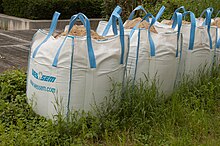Big bag
A bigbag ( English for large sack or large bag ) is a flexible bulk material container that looks and can be used like a large sack or a large bag (with handles / loops). The internationally used abbreviation is FIBC and stands as an abbreviation for Flexible Intermediate Bulk Container (English for flexible intermediate container for bulk goods ). Other names are bulk bag and jumbo bag.
The big bag was developed by Gustav Grolman GmbH & Co. KG, a distribution company for specialty chemicals from Düsseldorf. The name was granted trademark protection in 1978 in the form of grolman BIG BAG ; this expired in 2007.
A big bag holds about 1000 to 1300 liters. The maximum filling weight is indicated on the outside and is usually 1000 kg. It consists of a stable plastic fabric and can be refilled after emptying and, if necessary, cleaning, so it is reusable. Waste disposal companies mostly use disposable bags, which are incinerated if they contain flammable contents. Several stable loops are sewn on the open side, by which the container can be lifted for filling, transport or emptying. But there are also big bags available with an upper apron to close or with sewn-on filler or outlet nozzles. The fabric used is, for reasons of tightness and moisture protection, usually made of polypropylene , is provided or in part with an inner coating lined with foil liner. A large big bag fills the area of a Euro pallet and is filled to a height of approx. 1.5 meters.
With some bulk goods, due to their properties, the dust-free and metered emptying of the big bag causes problems. Special big bag dispensing machines have been developed for these cases.
Big bags are often used in disposal technology for lighter waste materials such as paper and scraps , but also for the construction of cofferdams . They are also used as inexpensive transport and final storage containers for residual materials (e.g. filter dust) in underground landfills. Big bags are also increasingly being used as product packaging for bulk goods such as wood pellets , almonds , cocoa beans , plastic granulate or for the transport of building materials (sand, gravel, crushed stone, paving stones, etc.) and seeds (maize, grain, potatoes).
In the event of flood disasters, big bags filled with sand are dropped or set down by helicopters in order to secure leaks at dykes .
Big bags filled with sand and gravel can be used as splinter protection barriers. B. serve in crisis areas, where they are called Hescoss .
In Rhöndorf , a district of Bad Honnef , big bags were set up in the vineyard in spring 2014 to ward off an assumed risk of falling rocks. After several reports, the big bags were accepted from an occupational health and safety point of view.
Big bags must meet the safety requirements of the Equipment and Product Safety Act (GPSG). The importer is responsible for compliance, if applicable. The load capacity of big bags (except hazardous goods big bags) is tested according to the ISO 21898: 2004 standard.
Pyramid knives or circular knives, for example, can be used to open big bags . Circular knives that create a web in the sack are particularly suitable for the automated emptying of dusty bulk materials. As a result, the bulk goods are spared from contamination by the sack.
See also
Web links
Individual evidence
- ↑ 1985.87 euros for the purchase of the "Big Bags" , General-Anzeiger Bonn, April 18, 2014
- ↑ Single-use big bags (single-use FIBC) and product safety . Judgment of the Hamburg Administrative Court of September 28, 2010
- ↑ ISO 21898: 2004 - Packaging - Flexible intermediate bulk containers (FIBCs) for non-dangerous goods. Retrieved April 25, 2017 .


